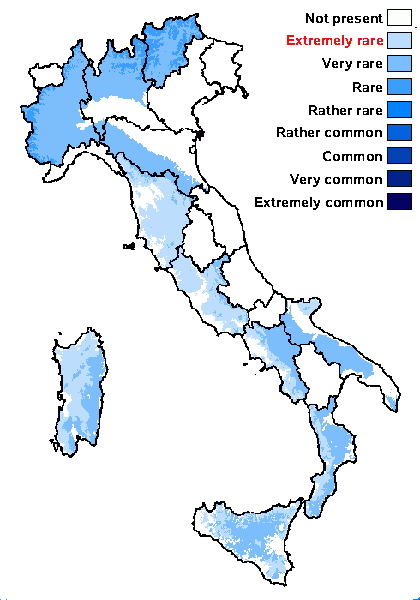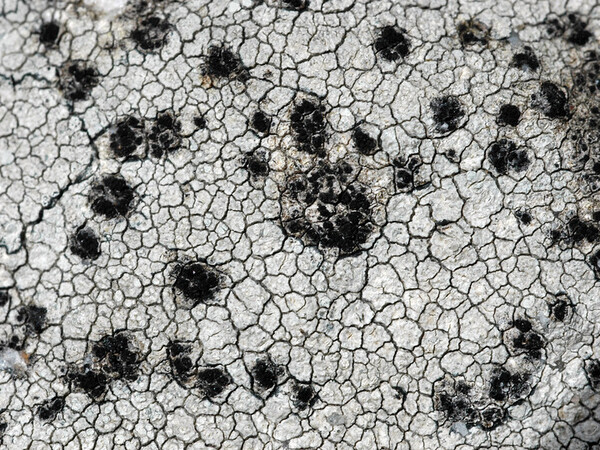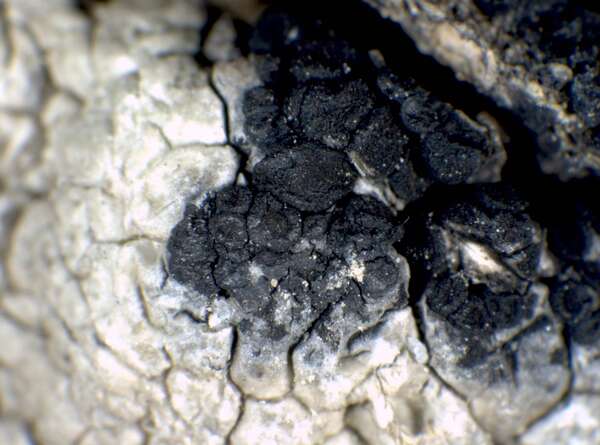Phacographa glaucomaria (Nyl.) Hafellner
Bibl. Lichenol., 100: 102, 2009. Basionym: Lecidea glaucomaria Nyl. - Nya Bot. Not.: 177, 1852.
Synonyms: Dactylospora maculans Arnold; Leciographa glaucomaria (Nyl.) A.L.Sm.; Leciographa maculans (Arnold) Rehm; Opegrapha glaucomaria (Nyl.) Källsten ex Hafellner; Opegrapha maculans (Arnold) Hafellner; Opegrapha maculans (Arnold) Hafellner ex Poelt & Türk
Distribution: N - TAA (Hafellner 2009, Brackel 2016), Lomb (Jatta 1909-1911), Piem, Emil (Tretiach & al. 2008, Hafellner 2009, Brackel 2016). C - Tosc (Jatta 1909-1911, Brackel 2016), Laz (TSB 8642 as A. intexta det. M. Grube), Sar (Monte 1993, Brackel & Berger 2019). S - Camp (Jatta 1909-1911), Pugl (Jatta 1909-1911), Cal (Hafellner 2009, Brackel & Puntillo 2016, Brackel 2016), Si (Ottonello & Romano 1997).
Description: Thallus not evident, not lichenized, parasitic on the thalli of Lecanora rupicola s.l. Apothecia black, arranged in dense groups of mostly 5-25, individual apothecia, 0.4-0.7 mm across, semi-immersed, with a widely exposed, rough, dark brown disc, and an often delicately fissured, black proper margin. Exciple 40-60 μm wide, dark brown; epithecium brown, granular, K-; hymenium colourless, 70-80 μm high including the epithecium, the hymenial gel hemiamyloid; paraphysoids branched and anastomosing, 2-3 μm thick, the apical cells 4-6 μm wide; hypothecium dark brown, 70-100 μm high; subhymenium 20-40 μm high. Asci (4-)8-spored, broadly cylindrical to subclavate, the wall I- and K/I- except for an apical ring that is K/I+ blue. Ascospores 3-septate, hyaline, 20-24(-26) x 6-7 μm, , with a thin perispore, the old ones with a brownish verruculose sculpture. Photobiont absent. Spot tests: all negative. Chemistry: no lichen substances.Note: a holarctic lichenicolous fungus with a wide altitudinal and latitudinal range, growing on the thalli of species of the Lecanora rupicola-complex; certainly neglected and occurring throughout the country wherever the host is present. The record from Friuli by Tretiach & Hafellner 2000) refers to P. protoparmeliae (Hafellner 2009).
Growth form: Lichenicolous fungus
Substrata: rocks
Reproductive strategy: mainly sexual
paras Lecanora rupicola s.lat.
Commonnes-rarity: (info)
Alpine belt: rare
Subalpine belt: rare
Oromediterranean belt: absent
Montane belt: very rare
Submediterranean belt: very rare
Padanian area: absent
Humid submediterranean belt: extremely rare
Humid mediterranean belt: absent
Dry mediterranean belt: absent

Predictive model
Herbarium samples
Growth form: Lichenicolous fungus
Substrata: rocks
Reproductive strategy: mainly sexual
paras Lecanora rupicola s.lat.
Commonnes-rarity: (info)
Alpine belt: rare
Subalpine belt: rare
Oromediterranean belt: absent
Montane belt: very rare
Submediterranean belt: very rare
Padanian area: absent
Humid submediterranean belt: extremely rare
Humid mediterranean belt: absent
Dry mediterranean belt: absent

Predictive model
| Herbarium samples |
 Index Fungorum
Index Fungorum
 GBIF
GBIF




